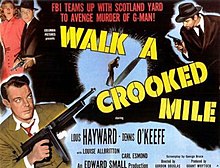Walk a Crooked Mile
| Walk a Crooked Mile | |
|---|---|
 Theatrical release lobby card | |
| Directed by | Gordon Douglas |
| Screenplay by | George Bruce |
| Story by | Bertram Millhauser |
| Produced by | |
| Starring | |
| Narrated by | Reed Hadley |
| Cinematography | |
| Edited by | James E. Newcom |
| Music by | Paul Sawtell |
| Color process | Black and white |
Production company | Edward Small Productions |
| Distributed by | Columbia Pictures |
Release date |
|
Running time | 91 minutes |
| Country | United States |
| Language | English |
Walk a Crooked Mile is a 1948 American anti-communist, Cold War crime film, directed by Gordon Douglas, starring Dennis O'Keefe and Louis Hayward.
Plot
[edit]This article needs an improved plot summary. (September 2024) |
Solid leads come to light about a Communist spy ring infiltrating the Lakeview Laboratory of Nuclear Physics, a southern California atomic research center. Federal Bureau of Investigation agent Dan O'Hara teams up with Scotland Yard detective Philip Grayson to hunt down the perpetrators responsible for the leak. At least one of the scientists at the nuclear lab is suspected of being involved in the clandestine espionage operation.
Cast
[edit]- Louis Hayward as Philip 'Scotty' Grayson
- Dennis O'Keefe as Daniel F. O'Hara
- Louise Allbritton as Dr. Toni Neva
- Carl Esmond as Dr. Ritter von Stolb
- Onslow Stevens as Igor Braun
- Raymond Burr as Krebs
- Art Baker as Dr. Frederick Townsend
- Lowell Gilmore as Dr. William Forrest
- Philip Van Zandt as Anton Radchek
- Charles Evans as Dr. Homer Allen
- Frank Ferguson as Carl Bemish
- Reed Hadley as Narrator
- Tamara Shayne as Mrs. Ecko (Landlady)
- Ray Teal as Police Sergeant
Production
[edit]The film was one of the first Cold War movies, and was made specifically to exploit the new anti-communist sentiment in the country after World War II. Producer Edward Smalls hoped to repeat the success he recently had with the films noir T-Men and Raw Deal. It was director Gordon Douglas' first major production; he had been making B movies for MGM.
The original title was Face of Treason, which was changed to FBI vs Scotland Yard. FBI director J. Edgar Hoover requested it be renamed again,[1] to FBI Meets Scotland Yard, but Small eschewed any collaboration with the agency, as he had discovered how controlling Hoover was when the FBI was involved in a cinematic project. Hoover was involved with a big hit, 1945's The House on 92nd Street, a movie about the FBI's pursuit and conquest of domestic Nazis that showcased the agency's methods and skills. By 1948, the House Un-American Activities Committee hearings about communist influence on the country were underway, and the FBI wanted a movie about this hot new topic, but Small refused to let Hoover co-produce the movie. Small also refused to grant the FBI power to approve the screenplay, so Hoover insisted all traces of the agency be removed from the film. Small refused once again; he held that fictional treatment of a public agency was legitimate. The only concession Small made was regarding the title, consequently The New York Times published a letter from Hoover disavowing any connection to the film and stating that he had not sanctioned it.[2]
Exteriors are mostly from San Francisco but the film starts with exteriors from Brand Boulevard, Glendale, California.[3][4]
Reception
[edit]When the film was released, The New York Times film critic, Bosley Crowther, while giving the film mixed review, wrote well of the screenplay, "No use to speak of the action or the acting. It's strictly routine. But the plot is deliberately sensational."[5]
The staff at Variety gave the film a favorable review, writing, "Action swings to San Francisco and back to the southland, punching hard all the time under the knowledgeable direction of Gordon Douglas. On-the-site filming of locales adds authenticity. George Bruce has loaded his script with nifty twists that add air of reality to the meller doings in the Bertram Millhauser story. Dialog is good and situations believably developed, even the highly contrived melodramatic finale. Documentary flavor is forwarded by Reed Hadley's credible narration chore."[6]
References
[edit]- ^ Scheuer, Philip K. (August 23, 1948). "Dennis O'Keefe Costar of Small's 'Dark Page;' Carmen, Wally Reunited". Los Angeles Times. p. 11.
- ^ Muller, Eddie. "Noir Alley: Walk a Crooked Mile (1948) Inro". You Tube. Tuner Classic Movies. Retrieved May 28, 2022.
- ^ CitySleuth (August 18, 2019). "Walk A Crooked Mile - 1 - Red Scare". Reel SF. Retrieved April 11, 2022.
San Francisco movie locations from classic films
- ^ CitySleuth (March 29, 2020). "Walk A Crooked Mile - 9 - Pier 36". Reel SF. Retrieved April 11, 2022.
- ^ Crowther, Bosly. The New York Times, film review, October 13, 1948. Last accessed: February 27, 2011.
- ^ Variety, film review. September 2, 1949. Last accessed: February 27, 2011.
External links
[edit]- 1948 films
- 1940s thriller films
- American anti-communist propaganda films
- American spy thriller films
- 1940s English-language films
- American black-and-white films
- Cold War spy films
- Film noir
- Columbia Pictures films
- Films shot in San Francisco
- Films produced by Edward Small
- 1948 drama films
- Films scored by Paul Sawtell
- Films directed by Gordon Douglas
- 1940s American films
- English-language spy thriller films
